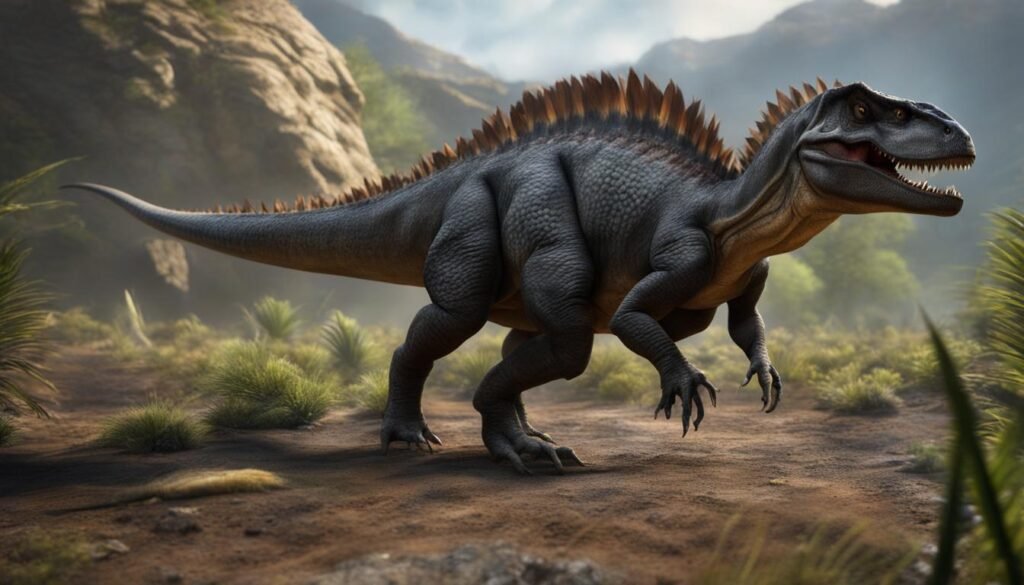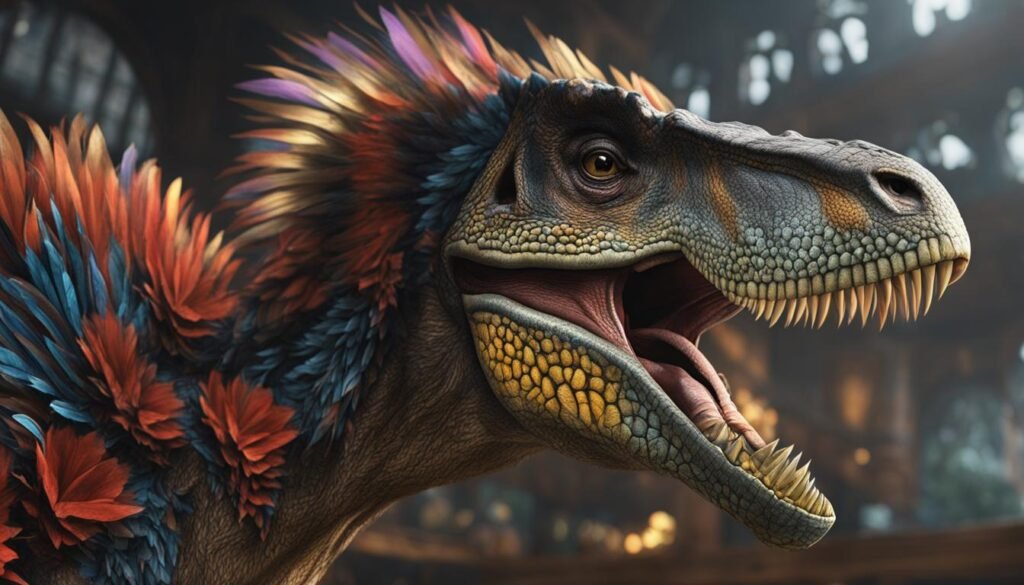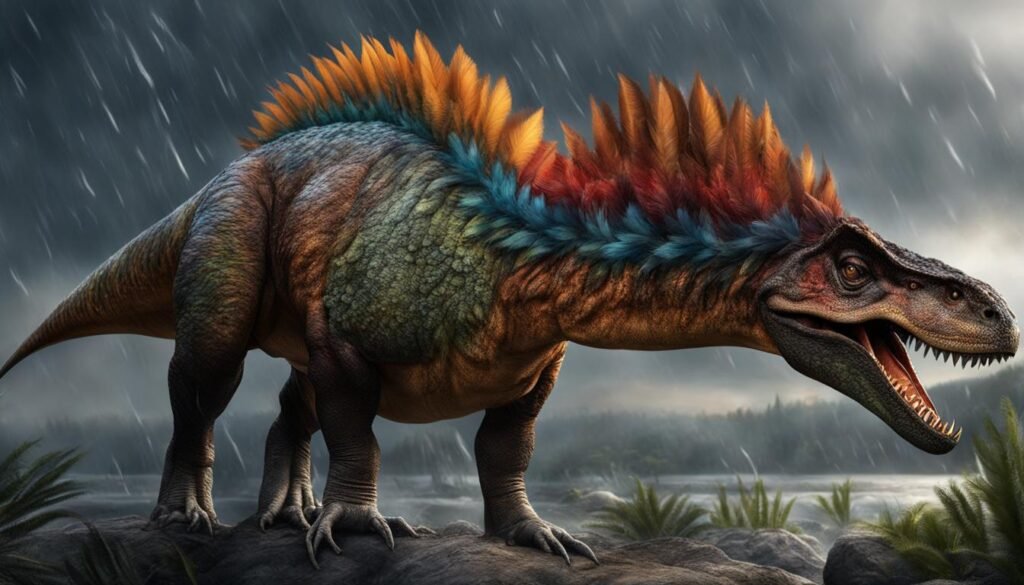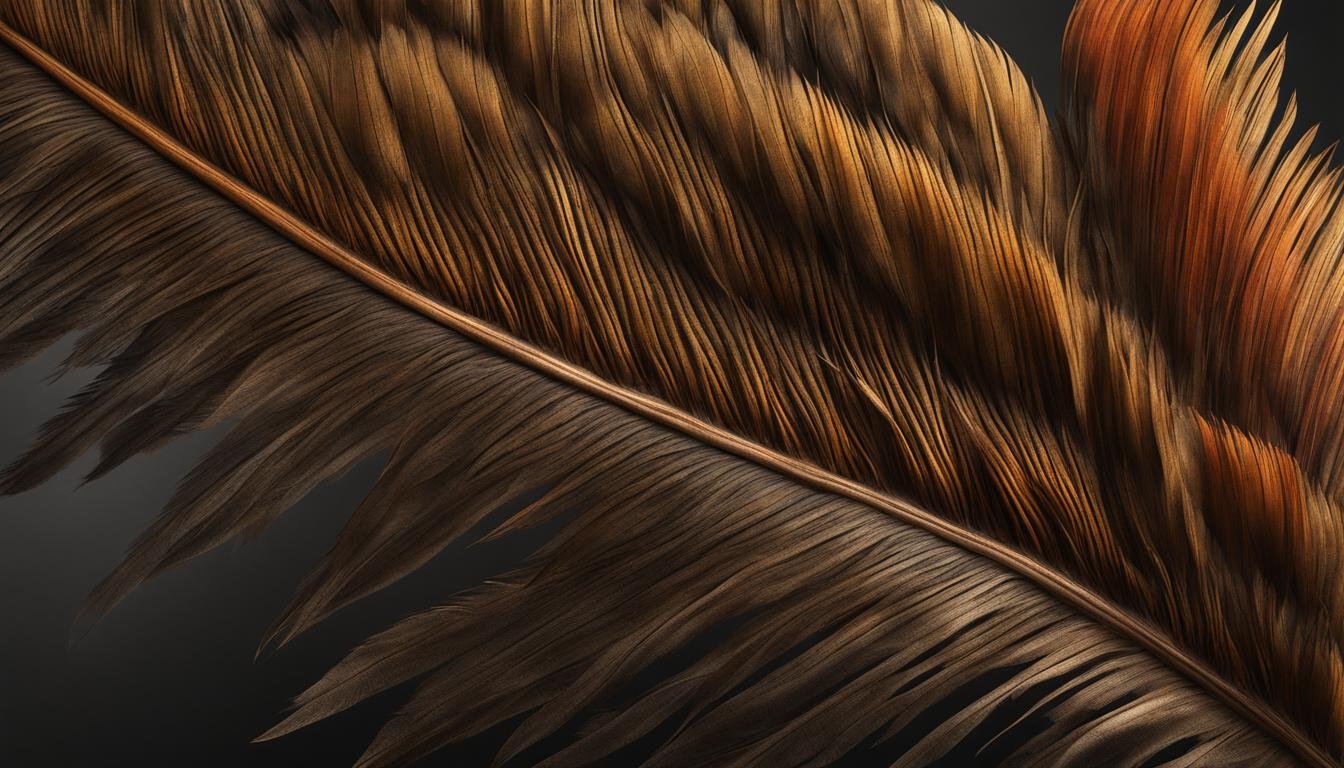Welcome to our exploration of dinosaur feathers and their fascinating form and function. In recent years, scientific research has revealed groundbreaking discoveries about these remarkable structures and their role in the evolution of dinosaurs. From thermal insulation to flight adaptations, dinosaur feathers have captivated the imagination of researchers and provided crucial insights into the ancient world of these incredible creatures.
Feather Structure and Development
Feathers, a defining characteristic of birds and their dinosaur ancestors, exhibit a complex structure that enables their diverse functions. The feather consists of a central shaft called the rachis, which is connected to a series of branches known as barbs. These barbs are further composed of smaller structures called barbules. The intricate arrangement of these components allows feathers to provide insulation, aid in flight, and serve as important factors in communication and display.
Feather growth begins with the development of a follicle in the skin, where the feather germs form. This process involves the elongation of a thickening in the epidermis called the placode into a tube-like structure. As the feather grows, the barb ridges develop, and the barbs fuse together to form the rachis. The growth of keratin cells in the follicle collar contributes to the formation of the feather. This remarkable process highlights the intricate nature of feather development and the remarkable evolutionary adaptations they possess.
Feathers are remarkable structures that have undergone millions of years of evolution. They are not just used for flight, but also play crucial roles in insulation, communication, and display in modern birds. The highly specialized structure and development of feathers demonstrate the intricate nature of nature’s design.
Understanding the structure and development of feathers provides insights into their incredible functionality and their evolutionary history. By studying the complexities of feather structure, scientists can unravel the evolutionary origins of feathers and gain a deeper understanding of the diverse functions they serve in avian and dinosaur species. Feather morphology and growth are fascinating areas of research that continue to captivate scientists and reveal the wonders of nature’s engineering.
| Feather Structure | Feather Morphology | Feather Growth |
|---|---|---|
| Consists of a rachis attached to barbs and barbules | Variations include flight feathers, downy feathers, and ornamental feathers | Feathers grow from follicles in the skin, with barb ridges forming and fusion of barbs to create the rachis |
| Provides insulation, aids in flight, and serves in communication and display | Diverse shapes and sizes for specific functions and adaptations | Development begins with the elongation of the placode into a tube-like structure called the feather germ |
| Complex arrangement enables diverse functions and evolutionary adaptations | Barbules and barbs create a versatile and functional structure | Growth involves the development of keratin cells in the follicle collar |
The Evolution of Feathers
Feathers have long been associated with birds, but their origins actually trace back to the dinosaurs. The evolution of feathers is a fascinating subject that continues to be studied and debated by scientists. Recent research suggests that feathers evolved in dinosaurs before the appearance of birds, making them an evolutionary novelty with no clear antecedents in ancestral animals.
The development of feathers can be traced through a series of transitional stages. It starts with a tubular elongation of the placode, a thickening of the epidermis, and progresses to the formation of barb ridges and the rachis, the main shaft of the feather. The process of feather evolution has been illuminated by advancements in the field of evolutionary developmental biology, providing valuable insights into the origins of this remarkable feature.
Feathers have undergone significant changes throughout history, evolving from simple structures to complex forms seen in modern birds. The adaptive advantages offered by feathers, such as insulation, display, and flight, likely contributed to their persistence and diversification. The study of feather evolution not only sheds light on the ancient world of dinosaurs but also provides a deeper understanding of how biodiversity flourished over millions of years.

The Stages of Feather Evolution
Feather evolution can be divided into several distinct stages, each marking a significant development in their structure and function. These stages include:
- Stage 1: Tubular placode formation – the initial elongation of the placode into a tubular structure.
- Stage 2: Barb ridge formation – the development of ridges along the length of the feather, where individual barbs will later emerge.
- Stage 3: Rachis formation – the fusion of barbs to create the main shaft of the feather, known as the rachis.
- Stage 4: Barbule formation – the growth of smaller structures called barbules, which interlock to give the feather its shape and structure.
These stages highlight the intricate process behind feather evolution and provide a framework for understanding the remarkable diversity seen in modern feathers.
| Stage | Description |
|---|---|
| Stage 1 | Tubular placode formation |
| Stage 2 | Barb ridge formation |
| Stage 3 | Rachis formation |
| Stage 4 | Barbule formation |
Functions of Dinosaur Feathers
Dinosaur feathers served a variety of functions that allowed these ancient creatures to adapt and thrive in their environments. These functions include:
- Thermoregulation: Feathers provided thermal insulation, helping dinosaurs regulate their body temperature. This was particularly important for species living in diverse climates, allowing them to stay warm in colder environments or cool in hotter ones.
- Camouflage: Some dinosaur feathers were adapted for camouflage, allowing these creatures to blend in with their surroundings and avoid detection by predators or prey. The coloration and patterning of feathers could mimic the environment, providing a significant advantage in hunting and survival.
- Display Features: Certain feathers may have had display features used in courtship rituals and sexual selection. Brightly colored or uniquely patterned feathers could attract mates or establish dominance within a species.
- Sexual Selection: In addition to display features, dinosaur feathers may have played a role in sexual selection. Males with more elaborate or unique feathers may have been preferred by females, leading to the passing on of desirable traits to future generations.
It is important to note that the exact functions of dinosaur feathers varied depending on the species and their environment. Some feathers may have served multiple purposes, while others were specialized for specific functions. The study of dinosaur feathers continues to provide valuable insights into the behaviors and adaptations of these ancient creatures.
Dinosaur Feather Functions Summary:
| Function | Description |
|---|---|
| Thermoregulation | Feathers provided thermal insulation, helping dinosaurs regulate body temperature. |
| Camouflage | Feathers allowed dinosaurs to blend in with their surroundings, enhancing their ability to hunt or avoid predators. |
| Display Features | Some feathers had elaborate patterns or colors used in courtship rituals or establishing dominance. |
| Sexual Selection | Feathers played a role in mate attraction and selection, influencing the passing on of traits in a species. |
The diverse functions of dinosaur feathers highlight the remarkable adaptability and evolutionary success of these ancient creatures. Through the study of feathers, scientists can continue to uncover the fascinating details of how dinosaurs utilized and evolved their plumage.
Fossilized Feathers and Paleoplumage
Fossilized feathers have provided researchers with a unique window into the appearance and structure of dinosaur plumage. These remarkable discoveries have revealed fascinating details about the diversity of feathers and the presence of melanin in ancient dinosaurs.
Analysis of fossilized feathers has shown that dinosaurs possessed a variety of feather types, ranging from long flight feathers to downy feathers for insulation. These feathers were composed of intricate structures called barbs and barbules, which provided strength and flexibility. The presence of melanin in fossilized feathers has also allowed scientists to speculate about the colors and patterns that adorned these prehistoric creatures.
The study of paleoplumage, or ancient plumage, has enabled scientists to reconstruct the appearance of dinosaurs and gain insights into their ecology and behavior. By examining the structure, size, and arrangement of feathers in different dinosaur species, researchers can make inferences about their lifestyle, habitat, and evolutionary adaptations. This field of study has opened up new avenues for understanding the complex relationship between feathers and the dinosaurs that wore them.
| Feather Types | Features |
|---|---|
| Flight Feathers | Long, stiff feathers adapted for powered flight |
| Contour Feathers | Medium-sized feathers that provide shape and streamline the body |
| Down Feathers | Soft, fluffy feathers that provide insulation |
| Filoplumes | Short, hair-like feathers used for sensory purposes |
Feather Functionality in Prehistoric Birds
Avian dinosaurs, including prehistoric birds, possessed feathers that served specific functions in their survival and adaptation. These feathers exhibited unique arrangements, contributing to various functionalities and providing insights into the behavior of these ancient creatures.
The feather arrangement on the wings and tails of prehistoric birds enabled flight, providing lift, propulsion, and maneuverability. The intricate structure and placement of feathers allowed for aerodynamic efficiency, allowing these avian dinosaurs to navigate the skies with precision.
Additionally, feathers played a crucial role in thermoregulation, protecting prehistoric birds from extreme temperatures. The feathers provided insulation, trapping air to maintain body heat in colder environments and helping cool the body in hot climates. The ability to regulate body temperature was crucial for survival and enabled these birds to thrive in diverse habitats.
The evolution of feathers in prehistoric birds underscored their success and adaptability, allowing them to conquer various environments and ecological niches. By studying the feather arrangement and functionality of avian dinosaurs, scientists gain a deeper understanding of the remarkable adaptations that emerged during the age of dinosaurs.
Feather Functionality in Avian Dinosaurs
| Feather Functionality | Description |
|---|---|
| Flight | Feather arrangement on wings and tails enabled lift, propulsion, and maneuverability during flight. |
| Thermoregulation | Feathers provided insulation, protecting birds from extreme temperatures by trapping air and regulating body heat. |
| Protection | Feathers shielded birds from external elements and potential predators, offering a layer of defense. |
| Courtship and Display | Ornamental feathers played a role in courtship rituals and mate attraction, allowing birds to display vibrant plumage and elaborate displays. |
Through their feathers, prehistoric birds showcased an incredible array of adaptations that contributed to their survival and success in the ancient world.
Molting and Feather Regeneration
The process of molting is essential for birds and dinosaurs to maintain healthy feathers. Molting refers to the shedding of old feathers and the growth of new ones. It allows them to replace damaged or worn feathers, ensuring optimal plumage for various functions such as flight, thermoregulation, and display. Feather growth and regeneration are intricate processes that take place within the follicles in the skin.
During molting, the old feathers are gradually pushed out by the growth of new ones. Feather growth begins with the development of a new feather germ, which elongates into a tube-like structure. Keratin cells within the follicle collar produce the components of the feather, including the rachis, barbs, and barbules. As the new feather grows, it pushes out the old feather, eventually replacing it completely.
The molting cycle varies among species and is influenced by factors such as age, breeding, and environmental conditions. Some birds molt once a year, while others may molt multiple times. The timing and duration of molting can be crucial for birds as it may affect their ability to fly, migrate, or regulate body temperature. Understanding the intricate process of molting and feather regeneration provides insights into the lifecycle and physiological adaptations of birds and their prehistoric counterparts, the dinosaurs.
Molting and Feather Regeneration: A Comparison
| Birds | Dinosaurs |
|---|---|
| Birds molt regularly, shedding old feathers and growing new ones to maintain optimal plumage. | Dinosaurs, including avian dinosaurs, also underwent molting and feather regeneration. |
| Molting cycles can vary among species, with some birds molting once a year and others molting multiple times. | The molting cycle in dinosaurs is still a topic of scientific study, but evidence suggests that they also molted. |
| The timing and duration of molting in birds can be influenced by factors such as breeding, age, and environmental conditions. | Factors that may have influenced the molting cycle in dinosaurs include growth rates, reproductive cycles, and environmental changes. |
In summary, molting and feather regeneration play a vital role in the life cycle of birds and dinosaurs. The shedding of old feathers and the growth of new ones ensure optimal plumage for various functions. While the molting cycle can vary among species and is influenced by different factors, the intricate process of feather growth and regeneration allows for the maintenance of healthy feathers.

Feather Coloration and UV Protection
Feather coloration in dinosaurs and birds is determined by the presence of melanin, a pigment that produces various colors. Melanin also provides UV protection, shielding feathers from the harmful effects of ultraviolet radiation.
The evolution of different colors and patterns in feathers allowed dinosaurs and birds to display a wide range of visual signals, including for communication, camouflage, and mate attraction.
According to research, feather coloration can serve as a signal of an individual’s health and genetic quality, influencing mate selection and reproductive success.
| Feather Coloration | Function |
|---|---|
| Bright and vibrant colors | Mate attraction and courtship display |
| Muted and camouflaged colors | Camouflage for avoiding predators or blending into the environment |
| Irregular or patterned colors | Disruptive coloration for confusing predators or prey |
Feather coloration can play a significant role in the survival and reproductive success of birds and dinosaurs. By using color to attract mates or blend into their surroundings, these animals had a better chance of finding food, avoiding predators, and passing on their genes to the next generation.”
In addition to coloration, the structure and arrangement of feathers also contribute to UV protection. The dense layer of feathers acts as a physical barrier, shielding the skin from direct exposure to ultraviolet rays. This UV protection is crucial for preventing damage to the DNA in skin cells and minimizing the risk of skin cancer.
The evolution of feather coloration and UV protection in dinosaurs and birds represents an adaptation to their environments. By harnessing the properties of melanin and developing various color patterns, these creatures were able to thrive and survive in diverse habitats.
Ornamental Feathers: Understanding their Behavioral Significance
Ornamental feathers, characterized by their elaborate colors, intricate patterns, and unique structures, have long fascinated scientists and researchers. These feathers, found in certain dinosaurs and birds, serve a behavioral purpose, playing a crucial role in attracting mates, establishing dominance, and signaling social status.
One notable example of ornamental feathers is found in the peacock, where the vibrant plumage of the male is used to court females during mating rituals. The extravagant display of the peacock’s feathers is a visual spectacle that showcases the individual’s genetic fitness and ability to provide for potential offspring.
“The flamboyant feathers of male peacocks have evolved through sexual selection, with females showing a preference for males with more extravagant displays. This preference has driven the evolution of elaborate ornamental feathers in the peacock population.”
Similarly, certain dinosaur species, such as the Anzu wyliei, possessed ornamental feathers that served a similar purpose. These feathers were used to attract mates and establish dominance within their social hierarchies. The study of these ornamental feathers provides valuable insights into the behavior and social dynamics of these ancient creatures.
Examples of Ornamental Feathers in Dinosaurs and Birds
| Dinosaur/Bird | Species | Ornamental Feathers | Behavioral Significance |
|---|---|---|---|
| Dinosaur | Anzu wyliei | Fan-shaped crest feathers | Mate attraction, dominance display |
| Bird | Peacock | Ornate tail feathers | Mate attraction, courtship |
| Bird | Bird-of-Paradise | Elaborate plumes | Mate attraction, courtship |
Further research into the functionality and evolution of ornamental feathers in dinosaurs and birds continues to provide valuable insights into the ancient world. By unraveling the mysteries of these magnificent feathers, scientists gain a clearer understanding of the intricate behaviors and social dynamics that existed among these fascinating creatures.

Feather Waterproofing and Insulation Properties
Feathers possess remarkable properties that make them essential for the survival of dinosaurs and birds in various environments. One of these properties is waterproofing, which protects the feathers from becoming waterlogged and compromising their functionality. The structure of feathers, including their barbs and barbules, forms a natural barrier against water, preventing it from permeating the feathers and reaching the skin. This waterproofing feature allows dinosaurs and birds to maintain their ability to fly, even in wet conditions.
In addition to waterproofing, feathers also provide excellent insulation properties. The shape and arrangement of feathers create air pockets that trap air and help regulate body temperature. This insulation is crucial for dinosaurs and birds living in cold environments, as it helps retain heat and prevents excessive heat loss. The combination of waterproofing and insulation ensures that dinosaurs and birds are equipped to thrive in a wide range of climates and habitats.
To further understand the importance of feather waterproofing and insulation, let’s take a closer look at the table below, which highlights the key features and benefits of these properties:
| Feather Properties | Waterproofing | Insulation |
|---|---|---|
| Function | Protects feathers from waterlogging | Maintains body temperature by trapping air |
| Importance | Enables flight in wet conditions | Prevents heat loss in cold environments |
| Structure | Barbs and barbules create a barrier against water | Feather arrangement forms air pockets for insulation |
| Beneficiaries | Dinosaurs, birds, and other feathered creatures | Dinosaurs, birds, and other feathered creatures |
In conclusion, feather waterproofing and insulation properties are vital adaptations that allowed dinosaurs and birds to thrive in diverse environments. These properties enable flight in wet conditions and provide insulation against temperature extremes. The unique structure of feathers, combined with their waterproofing and insulation properties, showcases the incredible adaptability and functionality of feathers in the ancient world of dinosaurs.

The Connection Between Feathers and Flight
Feathers played a crucial role in the evolution of flight in birds and flying dinosaurs. The unique structure and arrangement of feathers allowed for aerodynamic lift, thrust, and control during flight, enabling these creatures to conquer the skies. The adaptation of feathers for flight required various modifications in shape, size, and wing structure, which contributed to the development of different flight adaptations in birds.
One key adaptation is the presence of asymmetrical flight feathers on the wings. These feathers have a curved leading edge and a flat or concave trailing edge, creating a wing shape that generates lift and reduces drag. This enables birds to achieve sustained flight by generating the necessary aerodynamic forces to stay airborne. Additionally, the arrangement of flight feathers along the wings and tail provides propulsion and maneuverability, allowing birds to navigate through the air with precision.
Evolutionary changes in feather structure also facilitated the development of flight adaptations in dinosaurs. Fossil evidence suggests that certain non-avian dinosaurs, such as the Microraptor, had feathered wings that allowed them to glide or fly. The presence of flight feathers in these dinosaurs indicates a convergent evolution with birds, where similar adaptations for flight evolved independently in different lineages.
Feather Adaptations for Flight
| Adaptation | Description |
|---|---|
| Asymmetrical Flight Feathers | Curved leading edge and flat or concave trailing edge create lift and reduce drag during flight. |
| Wing and Tail Feather Arrangement | Provides propulsion and maneuverability, enabling birds to navigate through the air. |
| Lightweight and Flexible Feathers | Reduce weight and allow for efficient wing movement. |
| Hollow Shaft | Reduces weight while maintaining strength. |
In conclusion, the connection between feathers and flight is a remarkable example of evolutionary adaptation. The structural modifications in feathers, the arrangement of flight feathers, and the development of specialized wing structures have enabled birds and certain dinosaurs to achieve powered flight. The study of feather adaptations for flight provides valuable insights into the evolutionary history of these fascinating creatures and the principles of aerodynamics.
Conclusion
The remarkable diversity and functionality of dinosaur feathers have captivated researchers and inspired curiosity about the ancient world of dinosaurs. Feathers evolved in dinosaurs and played diverse roles, including thermoregulation, flight, display, and protection. The study of dinosaur feathers has enriched our understanding of dinosaur biology, speciation, and the evolution of flight in birds.
Dinosaur feathers provide valuable insights into the form and function of these prehistoric wonders. They have been a subject of fascination and scientific study, shedding light on the remarkable adaptations that allowed dinosaurs to thrive in various environments. From serving as thermal insulation to aiding in flight and courtship displays, feathers played a crucial role in the lives of dinosaurs.
By examining the structure, development, and fossil evidence of feathers, scientists have been able to trace their evolution and understand the evolutionary novelties they represent. Feather coloration, waterproofing abilities, and insulating properties all contributed to the success and survival of dinosaurs. The study of dinosaur feathers continues to uncover new discoveries and deepen our understanding of these incredible creatures.






